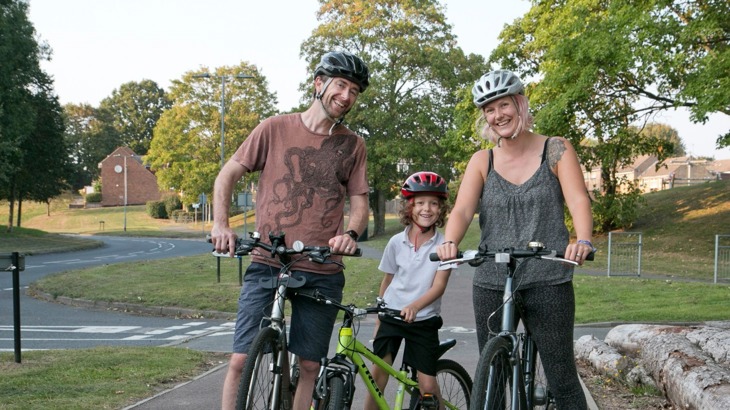Making sure all essential amenities are on our doorstep so we can easily walk and cycle there have lots of benefits for communities. Our Delivery Coordinator, Clare Dowling considers what a 20-minute neighbourhood is and looks at why we need safe routes for everyone.

20-minute neighbourhoods need to work for everyone, including children and other vulnerable people.
My local area is a 20-minute neighbourhood
I’ve been thinking a lot about street design recently. A recent Low Traffic Neighbourhood workshop re-sparked some real interest in my local area’s road layouts.
And it got me thinking about what they mean to me as a pedestrian, cyclist and parent.
I often talk about how lucky I am to live in Bracknell.
We moved here almost by accident in 2006 and since then have only moved 100m from the house we originally rented.
When Sustrans launched its 20-minute neighbourhoods manifesto for the 2019 general election, I realised that one of the reasons I love where I live is that it is a 20-minute neighbourhood.
What is a 20-minute neighbourhood?
The whole concept is that everyone’s daily needs can be met by ‘living locally’.
Everything a person needs is within a 20-minute walk. Shops, schools, work opportunities, amenities and recreation are all on a resident’s doorstep.
There are three primary schools and a secondary, my doctor’s surgery, dentist, vets, three sets of local shops, a nature reserve, a pub and a gym, plus numerous playparks all within a 10-minute walk of our house.
We’re also just 20-minute walk from the train and bus stations, and in the other direction from the local arts centre.
The Low Traffic Neighbourhoods training made me realise that I also live in a low traffic neighbourhood, designed to keep heavy traffic off the residential streets to reduce noise and air pollution and increase road safety.
A brief history of Bracknell
Bracknell was originally a market village on the edge of Windsor Great Forest and was designated one of eight New Towns in the late 1940s.
The town was planned using the neighbourhood principle - a population of 10,000 people in each area with its own schools, church and shops, community space, business space and pub.
There was a large amount of pedestrianisation, with the aim of all of those amenities being within less than a five-minute walk.
Whilst Bracknell’s population has grown to over 120,000 people, it still has a strong network of walking and cycling routes.
Many of the estates have ring roads, with all residential streets being no-through roads.
It has been interesting experiencing these routes over the past 14 years, as my life and priorities have changed.
Where it began
In 2008 I started working for Sustrans. And as my knowledge, skills and confidence on a bike increased, I cycled more and more.
I could make informed decisions about where to use the provided cycle route and where to take a more continuous, less congested or smoother road instead.
I understood more about cycle route design and would cycle huge distances on road where needed. I knew every cut-through within my local area and we would cycle for most of our journeys.
A different perspective
Life changed in 2013 when I became a parent. Though I cycled right up until two days before I gave birth, it wasn’t an option with a newborn in tow.
Those cycle paths that I had celebrated early on were not always fit for purpose whilst cycling with a baby.
And often there were no suitable bike racks at my destination to lean up a bike with a heavy child on the back to dismount him safely.
While the cycle routes beautifully connected up certain areas we needed to reach, there were gaps in the network.
The gaps were often at the busiest roads, on which I was not comfortable riding with a child seat and certainly not with a small child riding next to me.
Often the safest route was the longest or went up a steep incline that little legs struggled to manage.
Luckily, due to the setup of my local amenities and routes, I was able to start walking more. I didn’t have access to the car during the week due to my husbands’ commute, and so walking became the new cycling for me.
But I know this isn’t an option for everyone – the walking infrastructure in many places can also be unsuitable with a small child.
It’s been a huge learning curve for me to see the local routes through the eyes of a parent.
I suddenly started questioning where are our day-to-day journeys were taking us and having to consider more fully if the routes were suitable.
It’s fair to say I’ve had a huge shift in perspective.
Looking ahead
I’m lucky to live somewhere that doesn’t require complicated retro-fitting of cycling and walking paths, or changes to the road layout to keep heavy traffic off the residential roads.
But more widely, I can see a huge need for a range of interventions.
From the good design of residential areas, to continuous and well thought out routes to support the kinds of journeys we are more likely to be doing with children in tow.
This includes an understanding that the 20-minute neighbourhood model is not the limit of our world.
20-minute neighbourhoods are the future.
But we also need to ensure communities are connected to each other and are not just safe islands surrounded by impenetrable highways.





